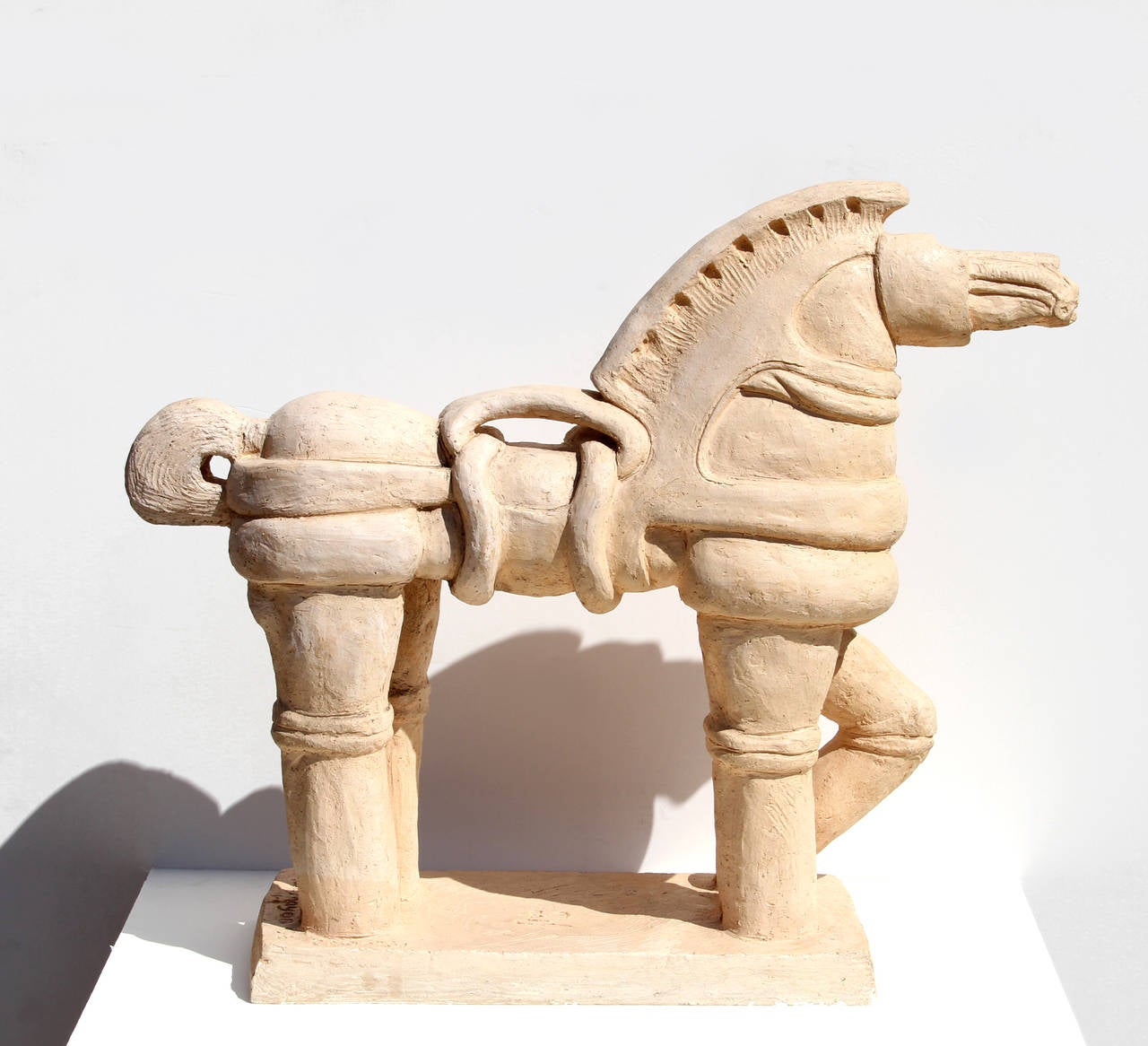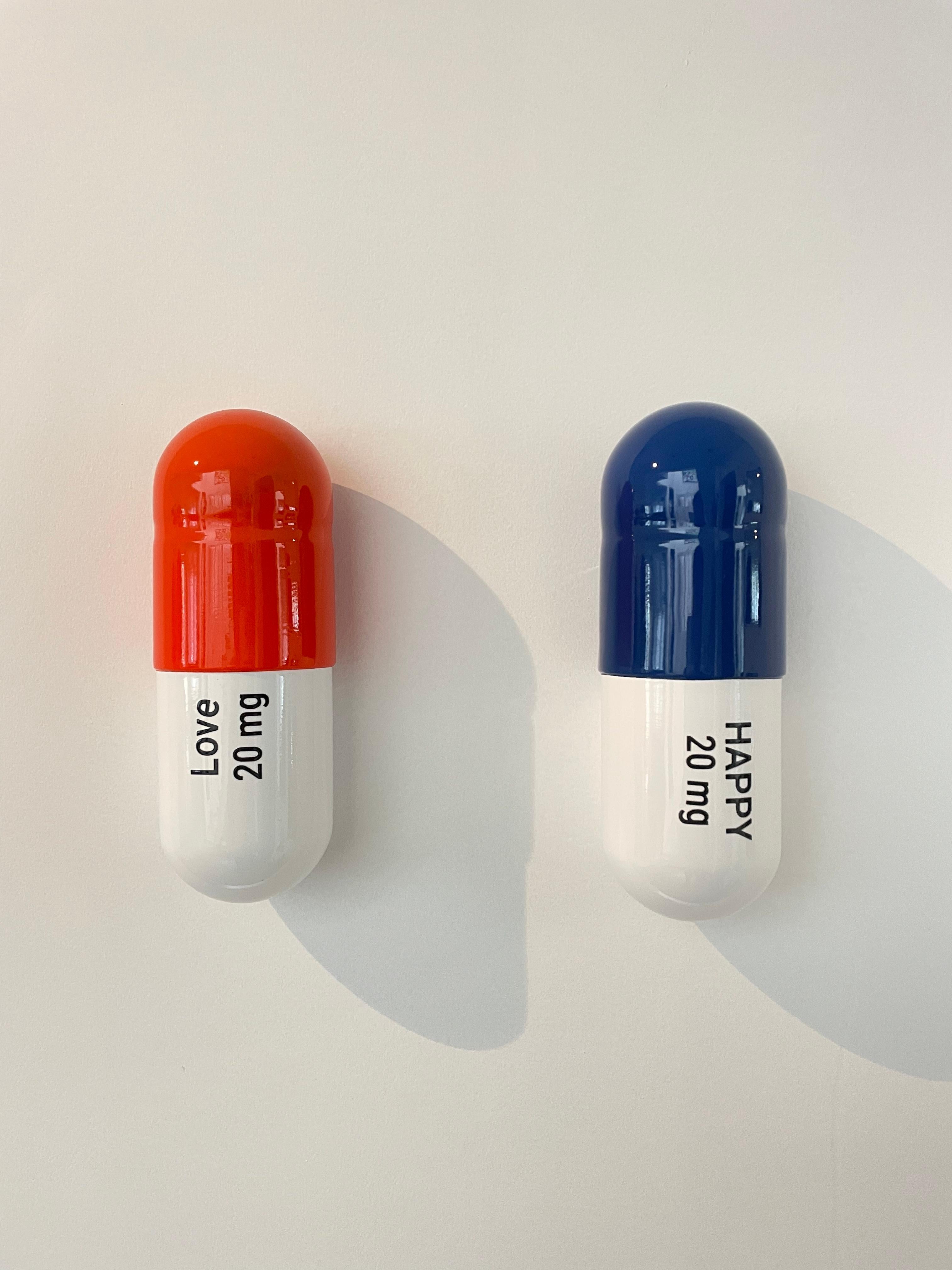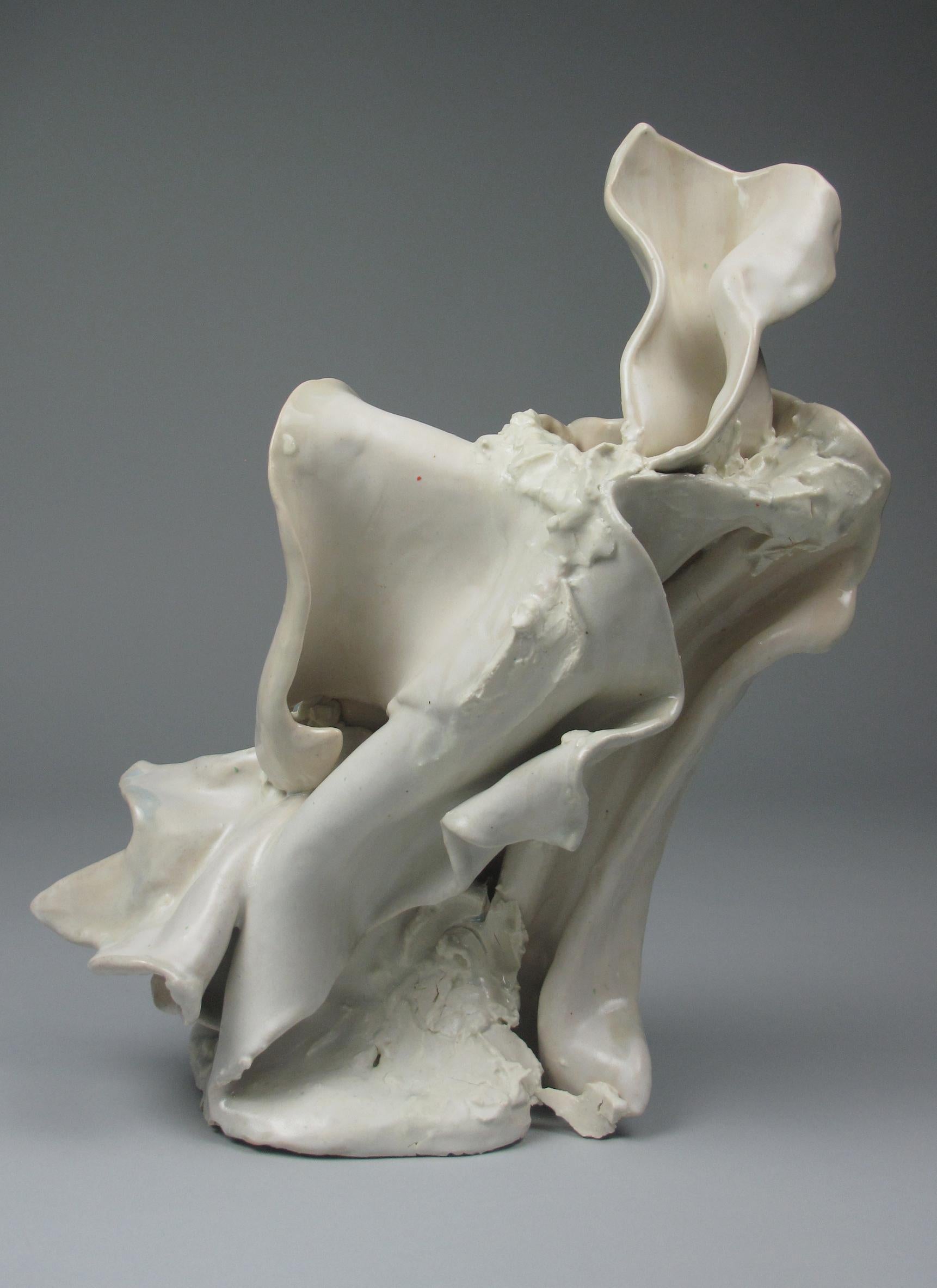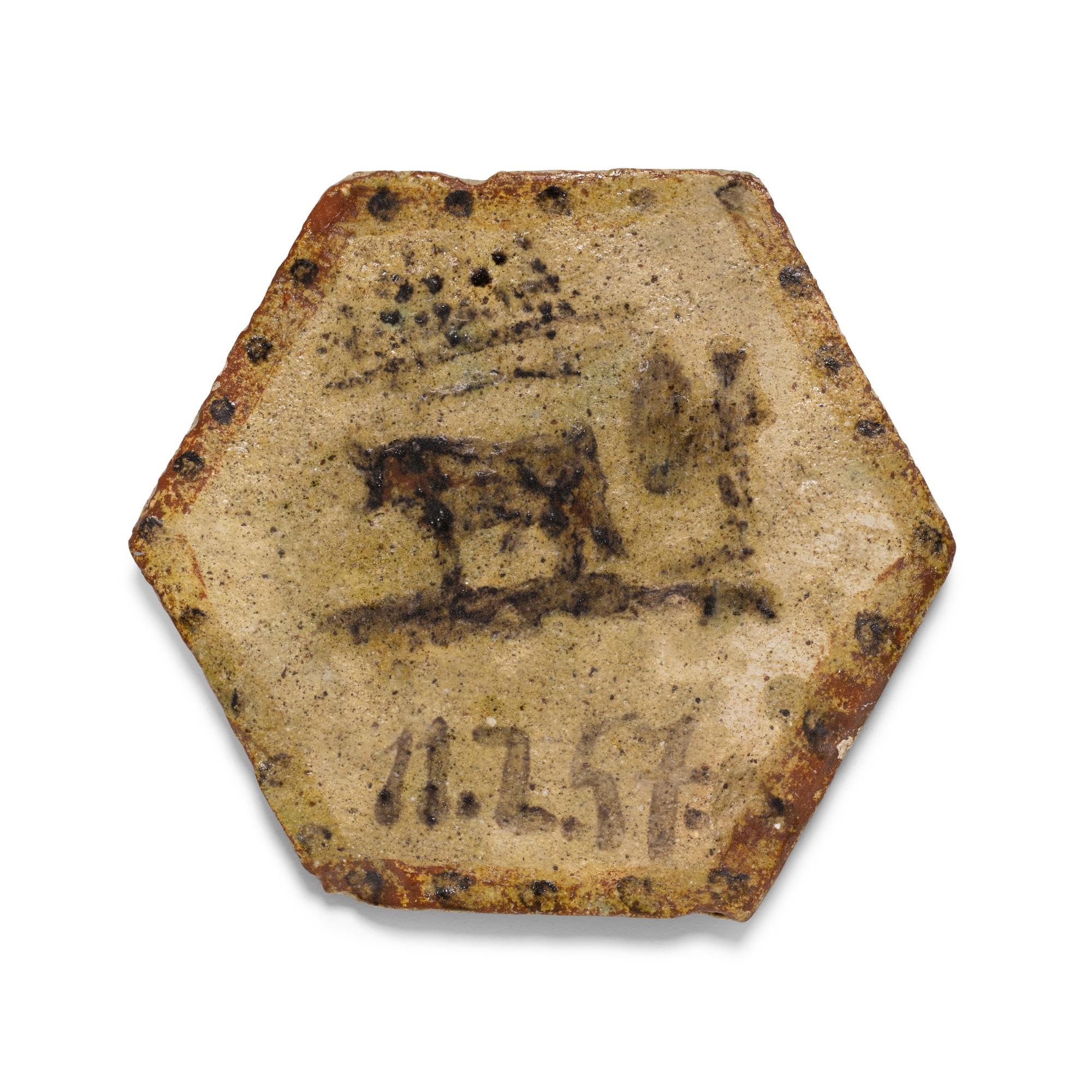Items Similar to "Moche Owl Pot, " Animalic Ceramic Vessel created in Pre-Columbian Peru
Want more images or videos?
Request additional images or videos from the seller
1 of 9
Unknown"Moche Owl Pot, " Animalic Ceramic Vessel created in Pre-Columbian PeruUnknown
Unknown
About the Item
This piece is a pot made by an unknown artist in Pre-Columbian Peru. It takes the shape of an owl and has a circular handle with the opening on its back. This pot is a light beige and red ocher color.
8" x 6" x 4 3/4"
Essay from Helene Bernier: "Moche society flourished on the north Peruvian coastal desert between the first and the eighth centuries A.D., in valleys irrigated by rivers flowing westward from the Andes to the Pacific Ocean. The Moche were innovators on many political, ideological, and artistic levels. They developed a powerful elite and specialized craft production, and instituted labor tribute payments. They elaborated new technologies in metallurgy, pottery, and textile production, and finally, they created an elaborate ideological system and a complex religious iconography.
Moche skilled ceramists produced a great variety of exquisitely decorated vessels. The decoration is sometimes painted on the smooth surface of vessels; other times it is tridimensional, forming the vessel shape itself. Occasionally, the message takes both a painted and sculpted form, one completing the other . Nearly all decorated vessels are slip-painted and bichrome, with red decoration on a white/cream background. White on red and black postfire paint are also present to a lesser extent. While painted motifs are generally simple on three-dimensional vessels, two-dimensional decoration sometimes takes the shape of finely painted, highly complex narrative scenes.
Moche decorated vessels were mold-made and, despite their diversity, reveal standardized shapes and decoration. Nine basic shapes are reported in the literature. Stirrup-spout bottles and flaring bowls are the privileged supports on which artists expressed figurative, complex painted scenes. Other shapes are neck and neckless jars, dippers, bowls, neck bowls, cups, and crucibles.
Moche ceramic art represents an infinite variety of subjects. Common zoomorphic figures include camelids, deer, felines, foxes, rodents, monkeys, bats, sea lions, as well as a wide array of birds, fish, shells, arachnids, and reptiles. These animals are represented realistically, hybridized, or anthropomorphized. Corn, squash, tubers, and beans are common among a great diversity of plants. Among human and anthropomorphic figures, rulers, warriors, prisoners, priests, healers, and fanged deities are recognizable, as well as deformed and skeletal individuals. Historical individuals are also represented in realistic, three-dimensional portrait vessels . While animals are often anthropomorphized or hybridized, humans often have supernatural attributes.
All these figures are either represented alone or interacting in a variety of actions in diverse narrative scenes. Although the possibilities of creating different scenes from all existing Moche figures are almost limitless, major trends can be recognized in narrative art and representations are limited to a small number of recurring and interrelated themes. For example, deer and seal hunts, sacrifice ceremonies, warriors in battle or moving in processions, and messengers running in line are common themes in Moche ceramic art.
Scholars do not agree about the various functions of Moche decorated ceramics. Until recently, these works of art were thought to be essentially funerary offerings, as they were documented in a great number of burials. Indeed, fineware is the offering par excellence in burials of any social status as a marker of Moche social identity. Decorated vessels were imbued with a strong funerary dimension. However, many vessels uncovered in Moche burials show traces of abrasion, chipping, or repairs.
Recent excavations in residential areas, notably in the Moche and Santa Valleys in projects carried out by Universidad Nacional de Trujillo and Université de Montréal, revealed that finely decorated pottery is not only present but abundant in Moche domestic compounds. Many decorated vessels were not produced exclusively for a funerary purpose. Whereas many of them were ultimately placed in burials or made especially for the dead, most were produced to be used by the living in everyday life. The access to decorated vessels by the living was not unrestricted; some categories of vessels, as well as depictions of some religious themes, were exclusively destined for burial with the dead or for use in elite ritual performances. However, a great variety of vessels, many of them identical to those found in graves, were destined for domestic use.
Vessels decorated with religious themes were not merely indicators of social status at the site of Moche. They were strategically used at a household level, as tools to further political ambitions and communicate membership within groups. As evidenced by their iconographic content and the location in which they were abandoned, decorated vessels were an integral part of household-level rituals, meetings, and other status-building activities like feasts, where they were displayed, used, accidentally broken, and in some cases given away along with food and corn beer."
- Creation Year:Unknown
- Dimensions:Height: 8 in (20.32 cm)Width: 6 in (15.24 cm)Depth: 4.75 in (12.07 cm)
- Medium:
- Period:
- Condition:item in excellent condition for its age, small holes on face of owl, some fading, chipping, and discoloration of slip coloring.
- Gallery Location:Milwaukee, WI
- Reference Number:
About the Seller
4.9
Platinum Seller
These expertly vetted sellers are 1stDibs' most experienced sellers and are rated highest by our customers.
Established in 1966
1stDibs seller since 2017
393 sales on 1stDibs
Typical response time: 2 hours
- ShippingRetrieving quote...Ships From: Milwaukee, WI
- Return PolicyA return for this item may be initiated within 14 days of delivery.
More From This SellerView All
- 'Can't Get Her Off My Mind' Ceramic SculptureBy Steven KemenyffyLocated in Milwaukee, WI"Can't Get Her Off My Mind" is an original ceramic sculpture created by Steven Kemenyffy. 43"x30"x14" Ceramic Steven Kemenyffy (born 1943) is an American ceramic artist living and working in Pennsylvania. He is most recognized for his contributions to the development of the American ceramic raku tradition. He has served as a Professor of Ceramic Art at Edinboro University of Pennsylvania (formerly Edinboro State College) since 1969. He Has retired from teaching, but continues to produce artwork at his home studio in McKean, Pennsylvania. Kemenyffy is often characterized in regard to his contributions to American experimental ceramics of the late 1960s and early 1970s. More specifically, Kemenyffy’s contributions to American raku techniques are often cited. Kemenyffy has stated that his interest in raku came out of practical considerations: “We [Steven and Susan] were doing a variety of workshops in a variety of different media. Raku was always an official way of making pieces in a short period of time…In raku it seems to compress all the firings into one.” Kemenyffy, himself, describes his early work as “Biomorphic forms alluding to old ceramic traditions such as tiles, vases, and containers.” These works were often in excess of six feet tall and many times included mixed media elements. In 1974, Kemenyffy wrote about the work he was producing; “For several years now, my work has dealt with certain formal considerations. Chief among these is using clay in such a way as to crystallize the moment and permanentize the impermanent. These have been among the primary concerns of all potters since the earliest times.” Today, Kemenyffy continues his pursuit of biomorphic imagery and themes. He writes, “Personally I am most challenged by the business of transforming porous organics into porcelain.” For much of Kemenyffy’s career, he has worked in tandem with his wife, Susan Hale Kemenyffy. In 1987 Susan stated about their collaborative works: “Steven is the [sculptor], I am the drawer. These works would not exist if it weren’t for the sculpture; if it weren’t for the clay. The clay entity comes first and my drawings come second.” James Paul Thompson further clarifies this relationship (as observed in 1987): “Steven Kemenyffy uses patterns as a point of departure for his work, while Susan Kemenyffy...Category
1980s Figurative Sculptures
MaterialsCeramic
- "Untitled Vase, " Neo-Expressionist Ceramic Vase signed by Michael GrossBy Michael GrossLocated in Milwaukee, WI"Untitled Vase" is an original ceramic vase by Michael Gross. It features abstracted and grotesque figures on a yellow ground. 11 1/2" x 4 1/2" art The ceramic sculptures of Wisconsin artist Michael Gross are personal narratives that reveal an unusual mix of earthly magic and primal vitality. The artist works in a variety of forms, including figurines, large vessels and furniture. With over a dozen museum exhibitions under his belt, the artist is a regular exhibitor at SOFA in New York...Category
1980s Neo-Expressionist Figurative Sculptures
MaterialsCeramic
- 'Untitled, Vessel' PorcelainLocated in Milwaukee, WIPorcelain 1.75" x 1.75" x 1.75" Sandra Byers creates these small nature-inspired translucent porcelain vessels using a variety of techniques. She begins s...Category
1980s Sculptures
MaterialsPorcelain
- 'Rabbit in Refrigerator' eathenware; glazedLocated in Milwaukee, WIEathenware; glazed 5 x 5Category
Late 20th Century Figurative Sculptures
MaterialsEarthenware
- "Undersea Living, " Ceramic signed on Verso by Bill ReidBy Bill ReidLocated in Milwaukee, WI"Undersea Living" is an original ceramic sculpture by Bill Reid. The artist signed the piece on the back and the title is stamped into the front. Reid's narratives have many humorous...Category
1980s Sculptures
MaterialsCeramic
- "Kite Series; Guardian III, " White Porcelain SculptureBy Marjorie MauLocated in Milwaukee, WI"Kite Series; Guardian III" is an original porcelain sculpture by Marjorie Mau. The work looks like a child's garment, but is executed in porcelain. It is creased and tucked at the n...Category
1980s Post-Modern Sculptures
MaterialsPorcelain
You May Also Like
- Horse - Taal Mayon, Sculpture by Ben GonzalesBy Ben A. GonzalesLocated in Long Island City, NYTitle: Horse - Taal Mayon Year: 1981 Medium: Terra Cotta Sculpture, signed and dated Size: 20.5 in. x 23 in. x 6 in. (52.07 cm x 58.42 cm x 15.24 cm)Category
1980s Modern Figurative Sculptures
MaterialsTerracotta
- 20 ML Happy Love pill Combo (navy blue orange white) - figurative sculptureBy Tal NehorayLocated in New York, NYThis new work by Tal Nehoray is from her latest body of works called "Happy Pills". All are hand made with ceramic and hand painted with automotive paint. It is a combination of 2 ce...Category
2010s Pop Art Figurative Sculptures
MaterialsCeramic, Automotive Paint
- Modern Abstract Stacked Brick, Concrete, and Stone Totem Outdoor SculptureBy Joe MancusoLocated in Houston, TXModern abstract outdoor totem sculpture by Houston artist Joe Mancuso. The piece is constructed out of various decorative brick, stone, and concrete piec...Category
1990s Abstract Abstract Sculptures
MaterialsStone, Concrete
- "Crimp", gestural, ceramic, sculpture, white, cream, stonewareBy Sara Fine-WilsonLocated in Natick, MASara Fine-Wilson's "Crimp" is a gestural 16.5 x 14 x 8 inch ceramic sculpture in white and cream constructed in white stoneware with porcelain...Category
2010s Contemporary Abstract Sculptures
MaterialsStoneware, Slip, Glaze
- "Protea 2", Contemporary, Porcelain, Abstract, Ceramic, SculptureBy Zemer PeledLocated in St. Louis, MOPeled was born and raised in a Kibbutz in the northern part of Israel. After completing a BA (Hons) at the Bezalel Academy of Art and Design in Jerusalem she graduated with an MA (H...Category
2010s Contemporary Sculptures
MaterialsCeramic, Porcelain
- Taureau et Toreador, Picasso, Bull, Corrida, Design, Tile, Ceramic, 1950'sBy Pablo PicassoLocated in Geneva, CHTaureau et Toreador, Picasso, Bull, Corrida, Design, Tile, Ceramic, 1950's Taureau et Toreador Unique work 11.2.1957 Painted and partially glazed ceramic, hexagonal tomette tile 15 ...Category
1950s Post-War Figurative Sculptures
MaterialsCeramic
Recently Viewed
View AllMore Ways To Browse
Antique Ceramic Vessel
Antique Food Art
Antique Ceramic Sculpture
Sculpture Display Case
Antique Ceramic Pots
Ceramic Pot Antique
Pre Columbian Art
Sculpture Of Owls
Antique Oceanic Art
Antique White Pot
Deity Sculpture
Three Birds Sculpture
White Ceramic Pots
Peru Sculpture
Antique Peru
Black Ceramic Figures
3d Shell Art
Cream Pot




